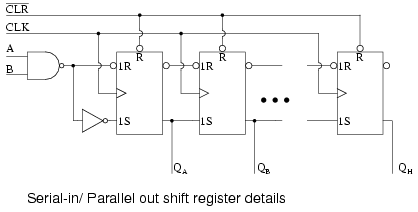
In electronics, a collection of flip-flops, which are memory elements, is known as a register. Shift registers are special types of registers. Using shift registers we can shift data through a series of flip-flops.
The Rebirth: the most mature and diversified album by the singer. As it was already mentioned, the disc The Rebirth is no ways the try by Bobby to change the image or his manner or writing – vice versa, the artist stays faithful to himself in everything. However, it is the manifest of a man, who is now independent and is responsible for himself. Bobby v the rebirth zippyshare lyrics. This is the discography of Bobby V, detailing his albums, singles, and featured appearances. Bobby V The Rebirth Zip mediafire links free download, download Bobby Valentino The Rebirth (2009) Www PLanetaElity blogspot com, Bobby Valentino The Rebirth Album 08022009 iHoneyJoo com, V A the rebirth of hardcore 1999 - bobby v the rebirth zip mediafire files.
5.7.4 Serial In/Parallel Out (SISO/SIPO) Shift Register. As the 'Parallel In/Serial Out' or PISO register also has a serial input, it can also be used as a SISO.
In brief, shift registers are sequential logic circuits, where a series of flip-flops are connected together in a daisy chain configuration to shift digital data from one flip-flop to another with every clock cycle. Shift registers are built using D flip-flops. If we connect four flip-flops in the configuration of a shift register, we get a 4-bit shift register. Generally, 8-bit (1 byte) shift registers are common. However, in this post, we will take a look at the different types of shift registers using only 4-bits or four flip-flops.
How do shift registers move data? We can feed and extract data to and from a shift register in two ways. • Serially: Data enters the cascade of flip-flops in a stream. Each bit passes through the cascade in a line. We get the data output at the last flip-flop. The output is in the same order as the input.
• Parallel: Each flip-flop can have its own input. This particular setting of giving input is known as parallel input. Similarly, each flip-flop can have its own output too. This is parallel output. So we have two ways in which data can ‘flow’ through a shift register. We can classify shift registers depending on these two data flow methods.
Doing that, we get four main configurations. The types of inputs and outputs of these four categories are evident from their names. • Serial In Serial Out shift register • Serial In Parallel Out shift register • Parallel In Parallel Out shift register • Parallel In Serial Out shift register So to quickly summarize a few things.
Shift registers are a series of flip-flops connected together through which data shifts. They have four main types. The difference between these four types lies in the way we input and output data to/from them. Apart from inputs and outputs, shift registers also have a clock input and a reset signal. The reset signal clears the contents of all the flip-flops. Additionally, since the clock input is given to all the flip-flops simultaneously, shift registers are also synchronous circuits. What are the uses of shift registers?
Since a shift register comprises of flip-flops, we can use them for the following general purposes • To shift data – Shift registers can shift data either to the right, to the left or in both directions. In this post, we will look at shift registers where the data moves in the right direction. • To store data – The flip-flops shift data on the application of a clock pulse. In the absence of a clock pulse, the shift register holds that data. • To produce a delay – The data can stay inside the shift register or pass through it.
Either way, the processes consume some clock cycles. So we can use them to introduce some delay if we need it. • To convert between serial-parallel – Since we have both serial and parallel types of inputs and outputs, we can use shift registers to convert serial data to parallel or vice versa. How to design a 4-bit Serial In Serial Out shift register (SISO)? Okay, so we know that we have 4 D flip-flops. All of them have the same clock input.
Desain brosur keren. And all of them have the same reset input. Since we have a serial input, we will take only one input port. This input port is to the first flip-flop in the register. Similarly, since we are taking the output serially. We will have only one output which will be taken at the output pin of the last flip-flop. From the above configuration, our SISO shift register will look like this.